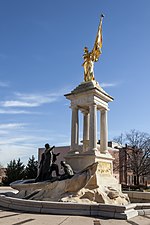Madison Avenue Methodist Episcopal Church
1857 establishments in Maryland19th-century Methodist church buildings in the United StatesAfrican-American history in BaltimoreBaltimore City LandmarksBaltimore Registered Historic Place stubs ... and 8 more
Central BaltimoreChurches completed in 1857Churches in BaltimoreChurches on the National Register of Historic Places in MarylandGreek Revival church buildings in MarylandMaryland church stubsMethodist churches in MarylandProperties of religious function on the National Register of Historic Places in Baltimore

Madison Avenue Methodist Episcopal Church, now known as Douglas Memorial Community Church, is a historic Methodist Episcopal church located at Baltimore, Maryland, United States. It is a brick, Greek Revival, temple-fronted structure featuring four fluted Corinthian columns and built 1857–1858. The rear addition is a two-story Colonial Revival style wing dating from about 1900.Madison Avenue Methodist Episcopal Church was listed on the National Register of Historic Places in 1992.Pastors at Douglas Memorial Community Church include Marion C. Bascom and Raphael Warnock.
Excerpt from the Wikipedia article Madison Avenue Methodist Episcopal Church (License: CC BY-SA 3.0, Authors, Images).Madison Avenue Methodist Episcopal Church
Madison Avenue, Baltimore
Geographical coordinates (GPS) Address Nearby Places Show on map
Geographical coordinates (GPS)
| Latitude | Longitude |
|---|---|
| N 39.303888888889 ° | E -76.627777777778 ° |
Address
Madison Avenue 1327
21217 Baltimore
Maryland, United States
Open on Google Maps










